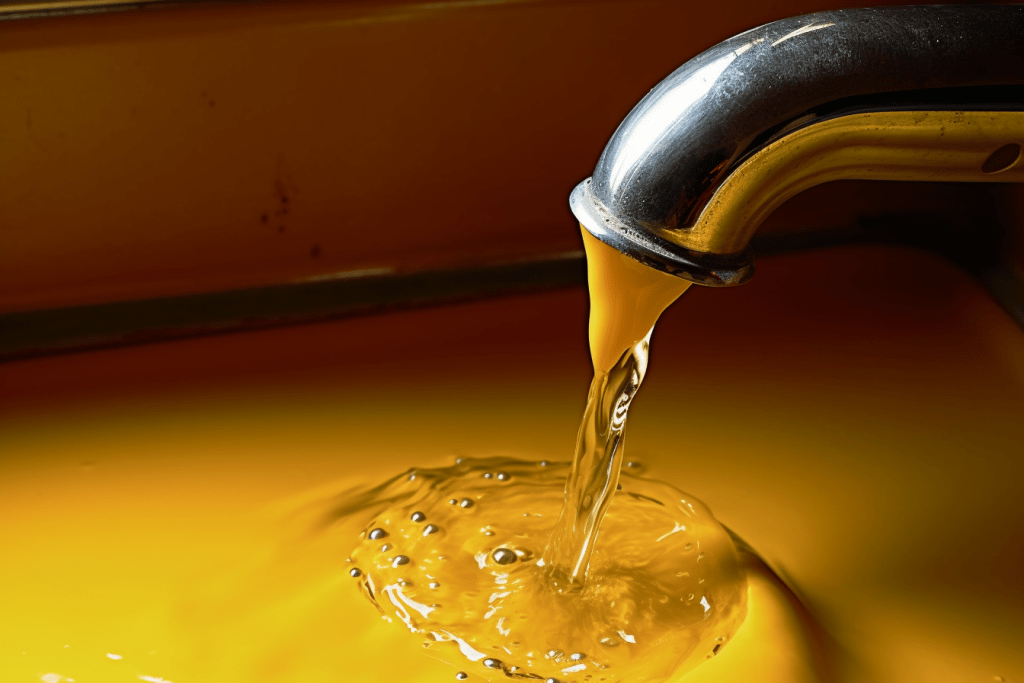
Have you ever turned on your faucet, only to find that your tap water is yellow?
It can be quite disconcerting.
In this article, we will explore the possible reasons behind this phenomenon and provide you with some solutions.
Understanding why tap water turns yellow can help you take appropriate action and ensure the safety of your drinking water. Let’s dive in!
Sediments in the Water
Sediments such as rust, sand, or clay particles can find their way into the water supply system.
Old or corroded pipes, especially in older buildings, can contribute to the presence of these sediments.
Solution: If sediments are causing yellow water, your local water utility company may have more information. They can flush the water lines or investigate if there is a problem with the distribution system.
Tap Water is Yellow from a Water Main Break
Water main breaks can introduce dirt and debris into the water supply.
This can result in temporary discoloration of tap water.
Solution: In such cases, contact your water utility company for additional information. They will work on repairing the break and restoring clean water to your area.
High Levels of Iron
Elevated iron levels in the water can lead to a yellow or rusty color.
Iron can enter the water supply through groundwater or corroded iron pipes.
Solution: Consider installing an iron filter or water softener system, especially if your water consistently has high iron levels. Consulting a water treatment professional can help you find the most suitable solution for your situation.
Presence of Manganese
Similar to iron, manganese can also cause yellowish water.
Manganese can naturally occur in groundwater or get into the water supply through corroded pipes.
Solution: If you suspect manganese is the cause, consider installing a manganese filter or contacting a water treatment professional for guidance.
Chlorine Interaction
Chlorine is commonly used to disinfect water and kill harmful bacteria.
When chlorine interacts with organic matter or sediments, it can cause water to appear yellow.
Solution: Allow the water to sit in an open container for a few minutes to allow the chlorine to dissipate. Alternatively, consider using a water filter with activated carbon to remove any chlorine taste or odor.
Berkey, Brita, and PUR filters all reduce chlorine levels while removing many other harmful contaminants.

Tannins in Water
Tannins are naturally occurring organic compounds found in plants and soil.
They can cause water to have a yellowish or tea-like color.
Solution: Although tannins are generally safe to consume, if you find the color unappealing, consider using a water filter with activated carbon or a specialized tannin-removal filter.

Seasonal Changes in Water Sources
During certain seasons, water sources may change due to rainfall or runoff.
These changes can introduce minerals or sediments into the water supply, resulting in yellow water.
Solution: The discoloration could be temporary and associated with seasonal changes. Allow the water to run for a few minutes until it clears. If the problem persists, contact your water utility company for further investigation.
Conclusion
If your tap water is yellow, understanding the reasons behind it can help you take appropriate action.
By identifying the specific cause, you can determine the best solution to address the issue.
Whether it’s sediments, iron, chlorine, or seasonal changes, there are steps you can take to ensure clean and clear tap water in your home. (Our water filter recommendations can help!)
If the problem persists or you have concerns about the water quality, reach out to your local water utility company or a water treatment professional for assistance.
Comments